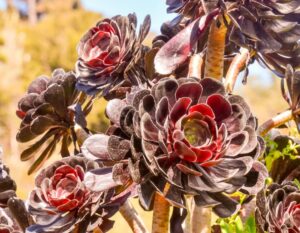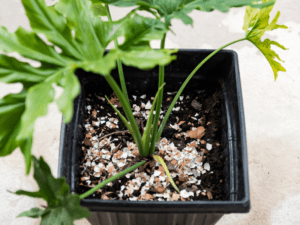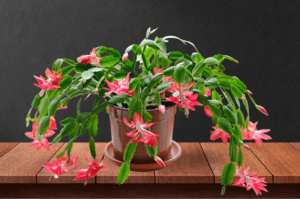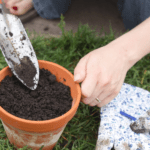Panicle Hydrangeas, with their stunning blooms and low-maintenance nature, are a perfect addition to any garden.
Their unique attributes, including their tolerance for different soil types and sun exposure levels, make them versatile and easy to care for.
They can be easily propagated, allowing you to expand your collection effortlessly.
Adding panicle hydrangeas to your garden will bring beauty and vibrancy without much hassle. This makes them a great choice for any gardener.
Understanding the Basics of Panicle Hydrangeas
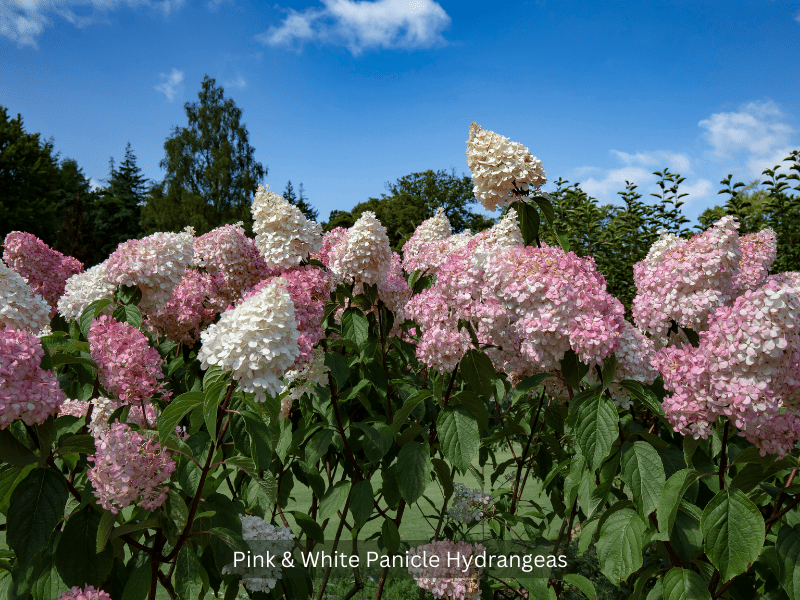
When it comes to understanding panicle hydrangeas, there are two key factors that are worth noting.
Firstly, the plant attributes, which play a crucial role in their growth and care.
Secondly, the common names, which shed light on how they are referred to.
Plant Attributes of Panicle Hydrangeas
Panicle Hydrangeas have various attributes that make them a wonderful addition to any garden.
The following are the unique characteristics of these plants:
- Versatile Growth: These plants are known for their ability to grow in a variety of conditions. This makes them adaptable and suitable for different environments.
- Large Flower Heads: These hydrangeas produce stunning flower heads that can range in size from small clusters to large panicles. The flowers start off as white or green and gradually change color as they mature.
- Long Blooming Season: One of the remarkable attributes is their extended blooming season, which can last from summer through fall.
- Drought Tolerance: Unlike some other hydrangea varieties, Panicle Hydrangeas are relatively drought-tolerant once established.
- Cold Hardiness: Another notable attribute of Panicle Hydrangeas is their ability to withstand colder temperatures compared to other hydrangea species. They can thrive in regions with harsh winters, adding beauty even in chilly climates.
- Attracts Wildlife: The large flower heads are not only visually appealing but also attract pollinators such as bees and butterflies to your garden.
Common Names of Panicle Hydrangeas
Panicle Hydrangea is a specific type of hydrangea. Its botanical name is Hydrangea paniculata.
They have other lesser-known common names, such as “PeeGee Hydrangea” or “Grandiflora Hydrangea.”
However, the most commonly used term remains “Panicle Hydrangea.”
How to Grow Panicle Hydrangeas
Sun Exposure and Soil Requirements for Panicle Hydrangeas
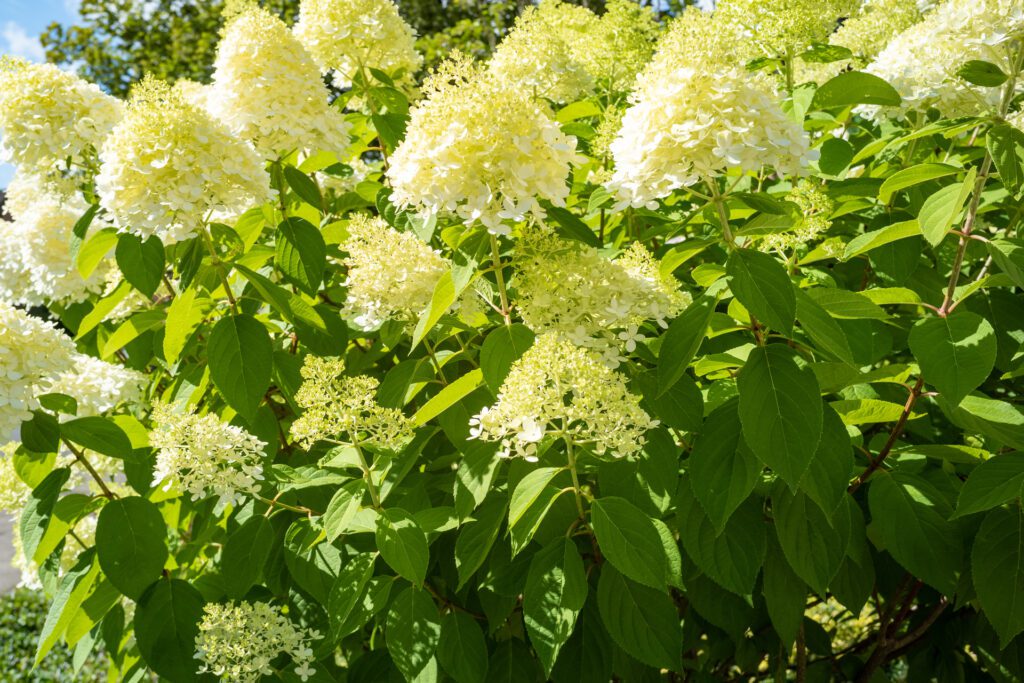
For Panicle Hydrangeas to flourish, it is crucial to find a location in your garden that receives adequate sunlight throughout the day.
While they can tolerate some shade, they will produce more abundant blooms when exposed to at least six hours of direct sunlight.
When it comes to soil requirements, Panicle Hydrangeas prefer a well-drained and fertile soil environment.
It is recommended to prepare the planting area by incorporating organic matter such as compost or aged manure into the soil.
This will improve its texture and enhance water drainage capabilities.
Adequate drainage is vital to prevent waterlogging, which can lead to root rot and other detrimental effects on the plant’s health.
Watering and Temperature Considerations
Panicle Hydrangeas thrive in specific watering and temperature conditions to ensure optimal growth.
Understanding these considerations is essential for maintaining healthy plants and vibrant blooms.
- Proper Watering Techniques: Consistent moisture is important for this plant, especially during the hot summer months. Water deeply, ensuring the soil is evenly saturated.
- Avoid Overwatering: Allow the top two inches of soil to dry out before watering.
- Temperature Sensitivity: Panicle Hydrangeas are adaptable to various temperatures but prefer moderate climates.
- Mulching Benefits: Apply a layer of organic mulch around the base of the plant to regulate soil temperature and retain moisture.
- Watering Schedule Adjustments: During periods of high temperatures or drought, increase watering frequency to compensate for additional moisture loss.
Fertilizing Techniques to Enhance the Health of Panicle Hydrangeas
By providing the appropriate nutrients, Panicle Hydrangeas can experience enhanced growth and vitality.
To achieve this, follow these 6 steps:
- Use a balanced slow-release fertilizer specifically formulated for hydrangeas.
- Apply the fertilizer in early spring, just as new growth begins to emerge.
- Spread the fertilizer evenly around the base of the plant, avoiding direct contact with the stems or foliage.
- Water the plant thoroughly after applying the fertilizer to help activate its release into the soil.
- Repeat the fertilization process every 4-6 weeks throughout the growing season.
- Monitor the health and appearance of your panicle hydrangeas to adjust the fertilizing schedule if needed.
You may also choose a fertilizer with a higher phosphorus content to promote flower production rather than excessive leaf growth.
Essential Care Tips for Panicle Hydrangeas
Pruning Guidelines for Panicle Hydrangeas
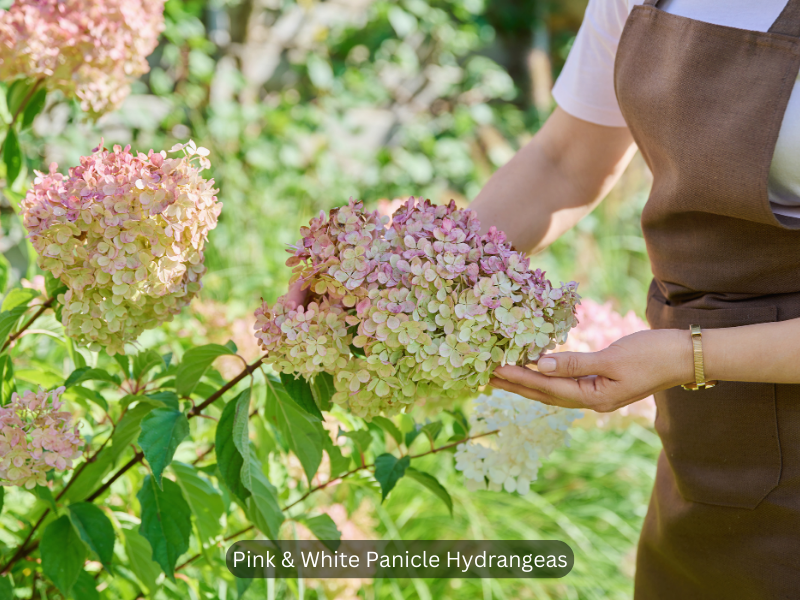
When it comes to pruning, there are some crucial guidelines to follow.
Here are three key points to keep in mind:
- Timing: Prune Panicle Hydrangeas during late winter or early spring, before new growth begins. This allows for the removal of dead or damaged branches without interfering with blooming later in the season.
- Deadheading: Remove spent flower heads after they have finished blooming.
- Size and Shape Control: If you wish to limit the size or shape of your Panicle Hydrangeas, you can selectively prune branches back to desired lengths.
Propagating Panicle Hydrangeas for More Beautiful Plants
To propagate Panicle Hydrangeas for more beautiful plants, follow this 6-step guide:
- Select Healthy Parent Plants: Choose mature Panicle Hydrangea plants that are disease-free and exhibit desirable traits.
- Take Cuttings: In early spring, using sterilized pruners, take 6-inch cuttings from new growth. Remove the lower leaves and dip the ends in the rooting hormone.
- Prepare Potting Mix: Use well-draining soil mixed with perlite or vermiculite to create a suitable rooting medium.
- Plant Cuttings: Insert the prepared cuttings into pots filled with the potting mix. Water thoroughly and place in a warm location with indirect sunlight.
- Provide Adequate Care: Keep the soil moist but not waterlogged, and mist the cuttings regularly. Monitor temperature to ensure it remains consistent for optimal root development.
- Transplanting: Once the roots have developed after about 8 weeks, gently remove the rooted cuttings from their pots and transplant them into larger containers or directly into the garden.
Common Pests and Diseases to Watch Out For
Panicle hydrangeas are susceptible to various pests and diseases that can hinder their growth and health.
Being aware of these common issues is crucial for maintaining the beauty of your panicle hydrangeas.
- Spider mites: These tiny insects feed on plant sap, causing yellowing of leaves and webbing on the foliage.
- Aphids: These small, soft-bodied insects cluster on new growth, sucking sap from leaves and causing distortion or stunting of plant growth.
- Powdery mildew: This fungal disease appears as a white powdery coating on the leaves and can weaken the plant over time.
- Cercospora leaf spot: This fungal disease causes brown spots with purple margins on the leaves, leading to defoliation if left untreated.
- Rust: This fungal disease appears as orange-brown raised spots on the leaves, stems, or flowers, affecting the overall appearance of the plant.
Regularly inspect your plants for any signs of infestation or infection.
Remove infected foliage promptly and dispose of it properly.
In addition, watering at the base of the plant rather than overhead can help prevent certain diseases.
Tips on Getting Panicle Hydrangeas to Bloom
To successfully encourage panicle hydrangeas to bloom, there are several key tips that every gardener should keep in mind:
- Provide Adequate Sunlight: Panicle hydrangeas thrive when they are exposed to full or partial sunlight. Ensure that your plant has access to at least six hours of direct sunlight each day.
- Choose the Right Soil: These hydrangeas prefer well-draining soil that is rich in organic matter.
- Water Regularly: While it’s important not to overwater, keeping the soil consistently moist is crucial. Water deeply once a week, or more frequently during dry spells.
- Prune Wisely: To promote blooming, prune panicle hydrangeas in early spring before new growth appears. Remove any dead or damaged branches and trim back older wood to encourage new growth.
- Provide Adequate Nutrients: Use a slow-release fertilizer specifically formulated for flowering shrubs in early spring and again in midsummer to provide essential nutrients for blooming.
- Be Patient: Panicle hydrangeas typically begin blooming in mid to late summer, so don’t be discouraged if you don’t see blooms right away.
Explore Different Varieties of Panicle Hydrangeas
Popular Varieties and Their Unique Features
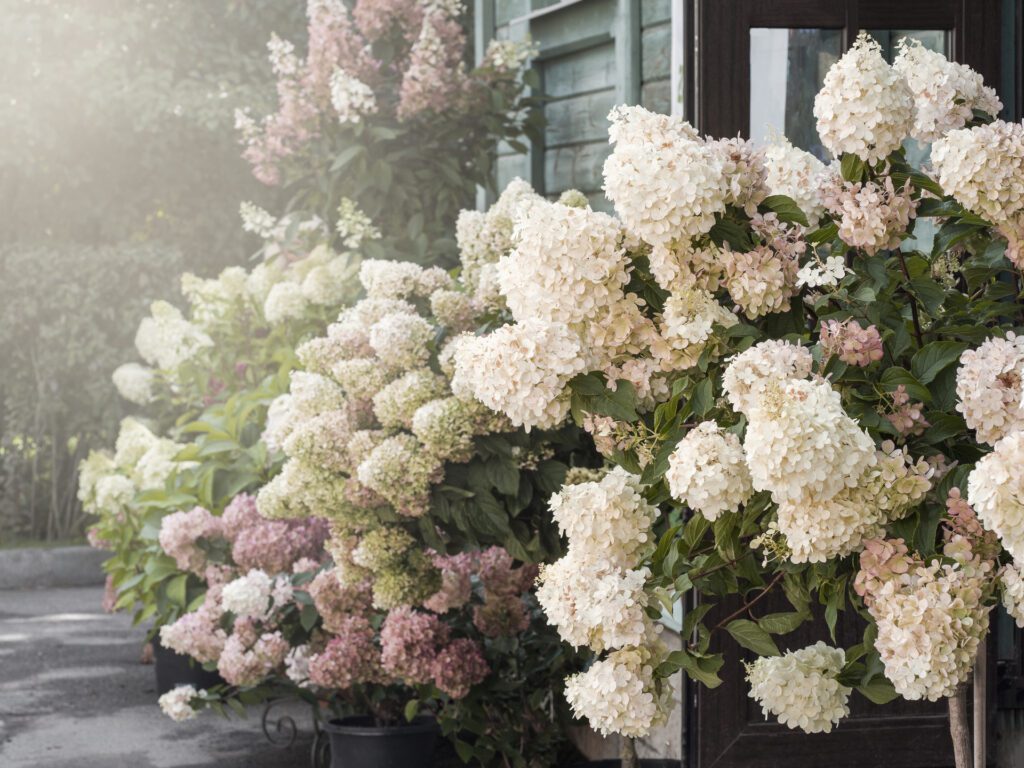
The diverse range of popular panicle hydrangea varieties offers unique features that make them a favorite among gardeners.
These varieties showcase distinctive characteristics and attributes that enhance the overall beauty of any garden.
Here are some of the popular varieties:
| Variety | Unique Features |
|---|---|
| Limelight | Large, conical flower heads that start off lime-green and transition to creamy white as they mature |
| Little Lime | Compact version of Limelight with similar color-changing blooms but perfect for smaller gardens or containers |
| Pinky Winky | Two-toned panicles with elongated flower heads that begin white and turn pink towards the tip |
| Vanilla Strawberry | Striking combination of white, pink, and strawberry-red flowers that gradually change color |
In addition to these popular varieties, there are many other cultivars available with their own distinct characteristics.
When choosing panicle hydrangeas, think about factors such as plant size, growth habit, flower color, and bloom time to create a visually stunning and well-balanced garden setting.
Selecting the Right Panicle Hydrangea for Your Garden
Panicle Hydrangeas offer a wide range of options for gardeners looking to enhance the beauty of their gardens.
When selecting the perfect plant for your garden, there are a few factors you should consider.
- Take into account the size and space available in your garden. Different varieties of Panicle Hydrangeas can vary in height and width, so choose one that will fit well without overcrowding the area.
- Consider the color preferences that you have for your garden. This plant comes in various shades of white, pink, and even deep red. Select a color that will complement the overall aesthetic of your outdoor space.
- Lastly, think about the flowering time of the different varieties. Some Panicle Hydrangeas bloom earlier in the season while others bloom later. Choose one that aligns with the blooming period you desire.
While these points help in selecting the right Panicle Hydrangea for your garden, it’s important to note that each variety has its unique features and requirements.
Conclusion
Panicle hydrangeas are not only beautiful but also low-maintenance plants that can enhance the aesthetics of any garden.
They boast stunning cone-shaped flower clusters that can range from white to pink.
These hydrangeas are known for their hardiness and resilience, requiring minimal care and attention. They are ideal for busy gardeners.
Now, you might find yourself yearning to experience the allure of panicle hydrangeas and the effortless beauty they bring to your garden.
FAQs
How to grow Panicle Hydrangea?
To grow Panicle Hydrangea, choose a location that receives at least six hours of sun a day and has well-drained soil. Plant the shrub and water regularly during the first year to help it get established. Prune in winter or early spring before the plant leafs out to strengthen stems and maintain the desired shape.
How to propagate Panicle Hydrangea?
Panicle Hydrangeas can be propagated through seeds or cuttings. To propagate from seed, collect the seeds from mature flowers in late fall and sow them in a seed tray or small pots filled with well-draining soil. Keep the soil moist and place the tray or pots in a warm, sunny location. For cuttings, take semi-hardwood cuttings in early summer and root them in a mixture of perlite and peat moss. Provide the cuttings with consistent moisture and indirect light until they develop roots.
How to care for Panicle Hydrangea in pots?
When growing Panicle Hydrangeas in pots, select a container that is at least 16 inches in diameter and has drainage holes. Fill the pot with a well-draining potting mix and plant the shrub at the same depth as it was in its nursery container. Place the pot in a location that receives at least four hours of sun a day and water regularly, allowing the soil to dry slightly between watering. Fertilize the plant with a granular shrub fertilizer in early spring and prune it as needed to maintain its size and shape.
How to encourage Panicle Hydrangea to bloom?
To encourage blooming in Panicle Hydrangeas, provide them with adequate sunlight. Plant them in a location that receives at least four hours of sun a day for the most prolific flowering. Water the shrubs regularly, especially during hot, dry spells, as they are more tolerant of dry conditions than other hydrangeas. Prune in winter or early spring before the plant leafs out to promote new growth and flowering.
Which are the popular selections of Panicle Hydrangeas?
Some popular selections of include ‘Limelight,’ ‘Bobo,’ ‘Little Lime,’ ‘Little Quick Fire,’ ‘Moon Dance,’ ‘Pinky Winky,’ ‘White Wedding,’ and ‘Zinfin Doll.’ These selections vary in size, flower color, and growth habit, offering a range of options for different garden settings.
How to repot Panicle Hydrangea?
To repot Panicle Hydrangea, choose a container that is slightly larger than the current one and has drainage holes. Fill the new pot with a well-draining potting mix and gently loosen the roots of the plant. Place the shrub in the new pot, making sure it is at the same depth as it was in its previous container. Fill in the gaps with additional potting mix and firm it gently around the roots. Water thoroughly after repotting and place the plant in a location with appropriate sunlight.

